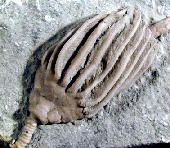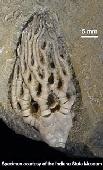|
 See More Images See More Images
(39 total)

Eucalyptocrinites crassus
© 2004 Indiana State Museum, Indiana Geological Survey, and Indiana University

Saccosomopsis insperatus
© 2005 The Virtual Fossil Museum

Cyathocrinites multibrachiatus
© 2004 Indiana State Museum, Indiana Geological Survey, and Indiana University
|
What are Crinoids? These animals are relatively rare in modern seas, but were prominent members of many Paleozoic marine communities. There are two forms, stalked and unstalked, both of which feed by catching floating particles with their tube feet and passing them down to their mouths. The “sea lilies,” , or stalked crinoids, have flexible stalks made of numerous small disks of calcium carbonate, and a sac-like body with feathery arms that are used to trap food.
The “feather stars” lack a stalk and a distinct body. They swim around reefs by flexing their feathery arms. First known fossil occurrence: Cambrian. Last known fossil occurrence: Quaternary. This group has living relatives. Cool Crinoids links: Search for images of Crinoids on Google |
|




